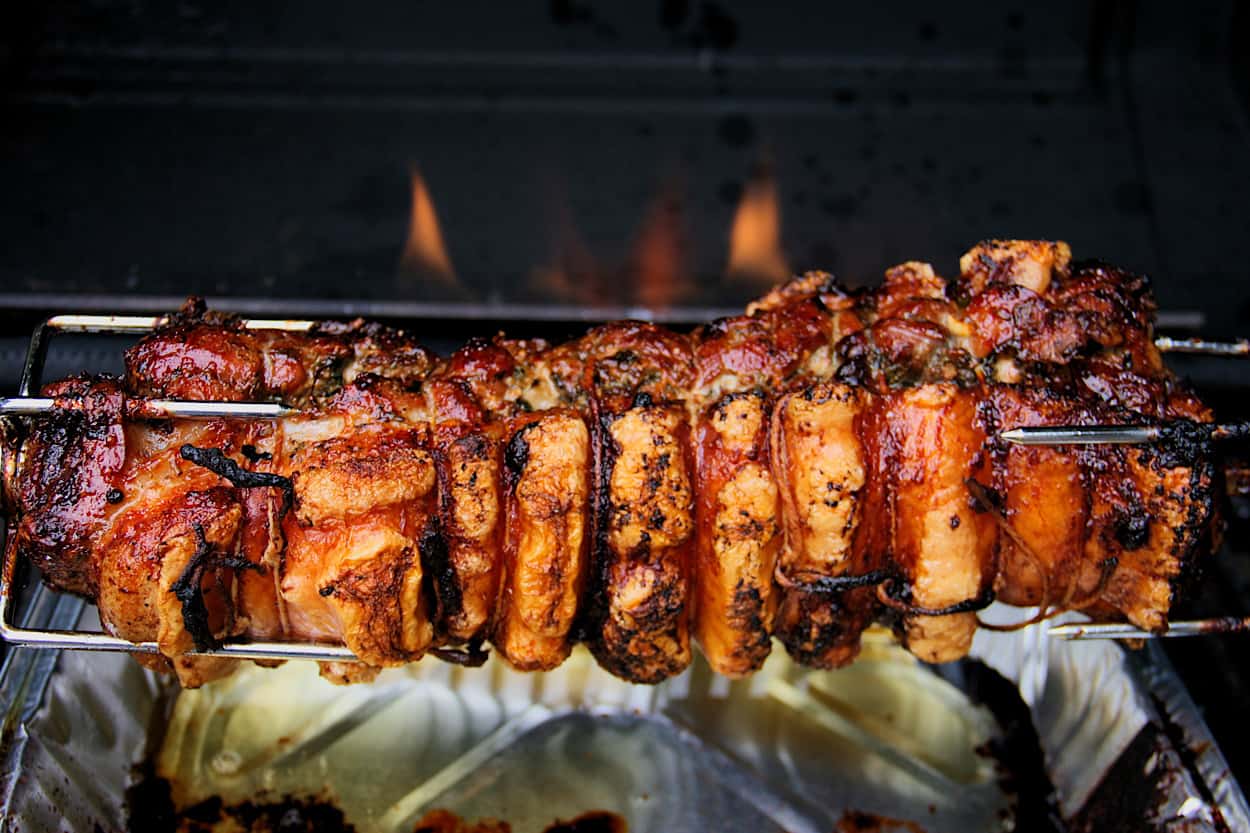
Traditional Italian Porchetta
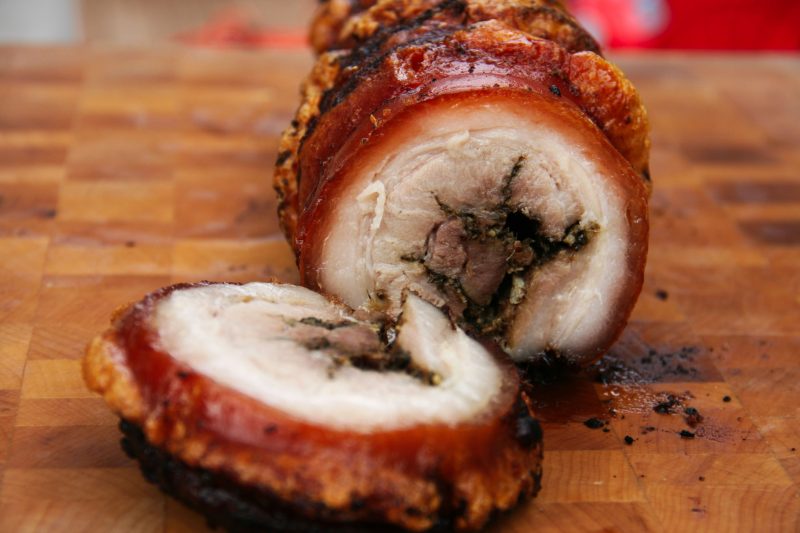
Fall is coming, and with the changing of the seasons I also like to change up what I am putting on my grill. Pork starts to play a more prominent part in my family’s meals; its inexpensive and bursting with flavors and textures ready to be extracted with simple techniques. So, when the leaves start to fall, or the thermometer starts to dip, I always dive into the recipe books for one of my all-time favorites; Porchetta.
Porchetta, (pronounced Por-Kett-ah), has been ruling the Italian street food scene since the fall of the Roman republic. Traditionally made with a whole deboned suckling pig (stuffed with spices, herbs, and tons of garlic), that was slow roasted on a spit till the meat was tender and the skin was crispy and bubbly. In today’s markets it’s a lot harder to get a hold of a suckling pig, and I am usually not feeding large crowds, but we have another cut that is perfect for the task; Pork Belly.
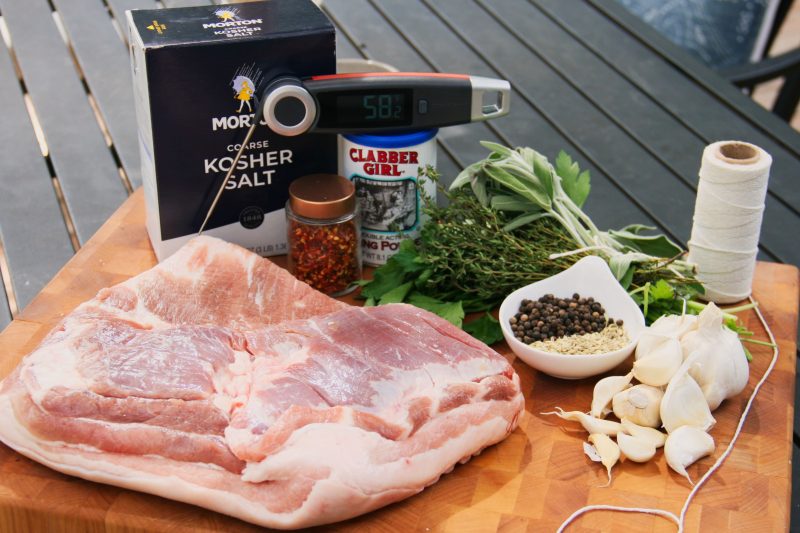
Table of Contents
MYTHS AND TRADITIONS
Some traditionalists claim that you have use two cuts, the belly, and the loin, to make a true porchetta but I wholly disagree. Today’s pork loins are so lean that they are comparable to chicken breasts, or as the government denotes, “extra lean”. In the olden days pork was a much fattier animal, and thus the loins were more marbled and much smaller. If we were to use a loin, which is considered cooked at 145° F (63°C), it would be dry and inedible by the time the belly (which is full of connective tissue and collagen) reaches its target temp of 170°F (77°C). No crispy skin, rubbery meat, and a dry inedible center, no thank you.
There is a myth that fat keeps other meats moist or helps lock in juices, this is not only wrong but bad food science as well. As meat is cooked the muscle fibers tense and tighten, squeezing the water in the meat out. Fat is not water, it’s an oil and therefor it cannot cross the same barrier that water did and make its way into the meat. The fat can coat the outside of the meat tricking your mouth into thinking for a moment that you are eating a juicy cut of meat, only to be disappointed as you start to chew. Fat wrapping has its place, adding flavor and some protection, but keeping things juicy is not one of them.
For this recipe we are going to make a Porchetta using the belly, one of the most forgiving and delicious cuts of pork. While this dish is simple, it will require patience to make perfect.
HOW TO PREPARE THE PORCHETTA
The key to any great porchetta is your seasoning mix. Here we use a mix of dry spices and fresh herbs with loads of minced garlic and salt to deeply permeate the meat. The longer the salt sits on the muscle fibers the more magic it will create. In the same way a brine helps keep moisture in, the salt will break down the proteins in the meat changing its structure to hold on to more moisture and firm up the flesh. This will help keep our finished porchetta juicy with a tender texture.
SEASONING THE PORCHETTA
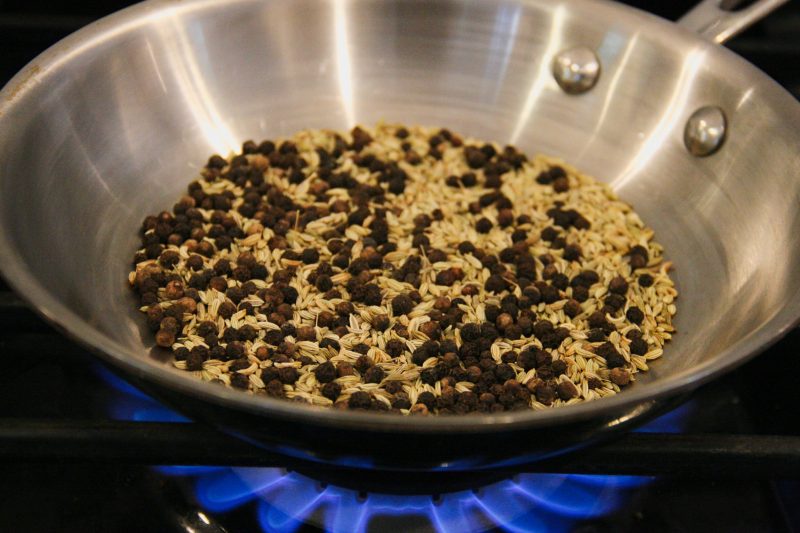
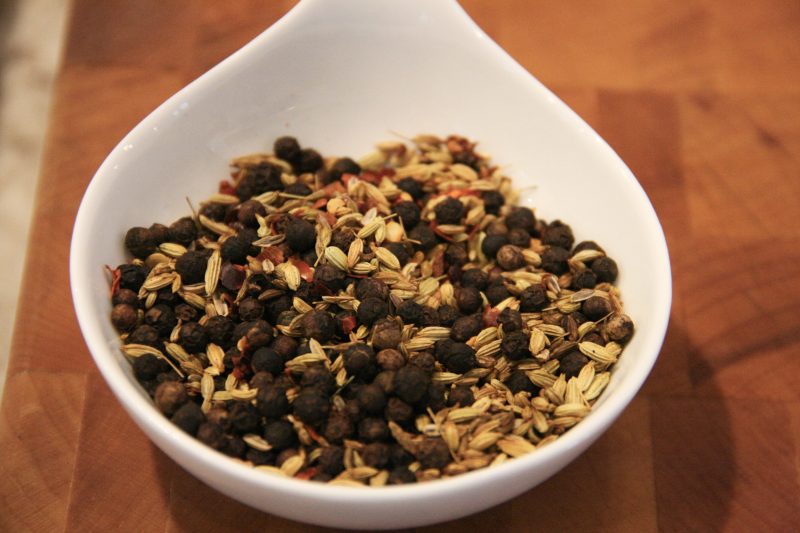
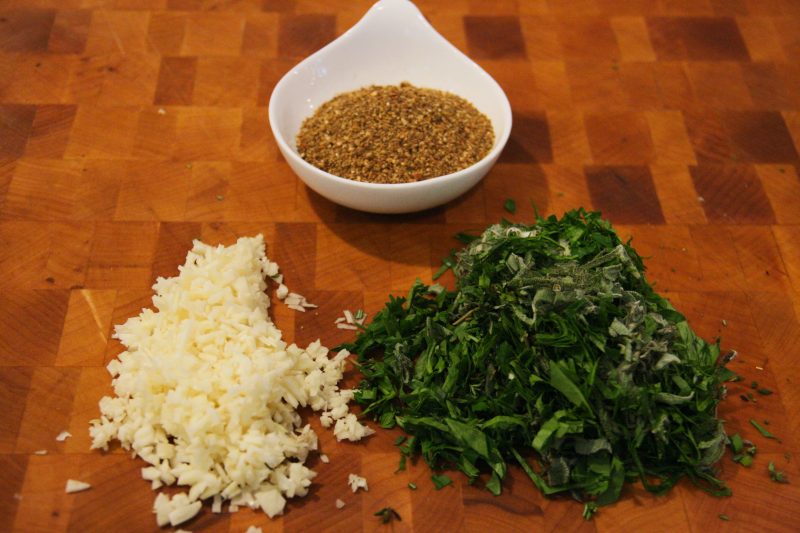
Start by toasting your dry spices, here I am using black peppercorns and fennel seeds. This will awaken the oils and make for much bolder and more fragrant spices. We want to toast these until they are lightly browned and your kitchen smells of fennel and pepper. Remove them from the pan and let them cool so they do not continue to cook and burn. Once cooled pulse them in a spice grinder till they are coarsely crushed (you can use a mortar and pestle for this as well). Once ground, mix with your fresh herbs, minced garlic and crushed red pepper (while you may think this will make it spicy it will not. The pepper flakes bring out and accentuate the companion flavors in the mixture.
Lay the pork belly out on your cutting board skin side down then, using a sharp knife, score the meat halfway through the flesh making sure to not cut all the way through the skin.
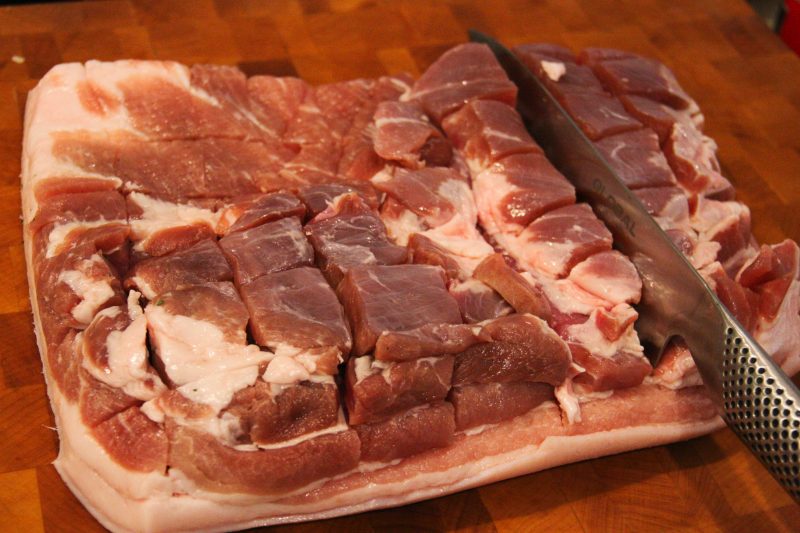
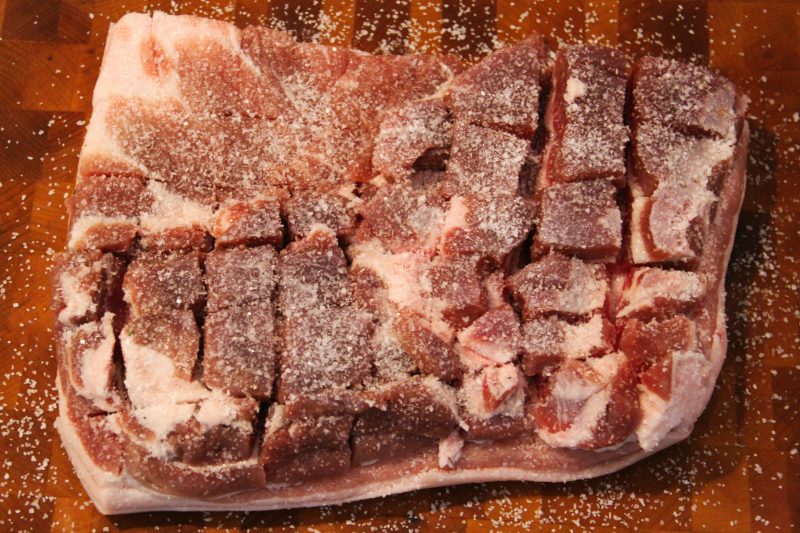
Liberally season the belly with salt.
You want to do this first, so the salt is in direct contact with the meat before you add your spices.
Next rub the spice and herb mixture all over the meat, making sure to get into all the score lines you made.
Next, we roll, but before you do go ahead and cut 10-15 strings of butchers’ twine long enough that they can wrap all the way around the pork and still have room to tie them (if in doubt add another few inches).
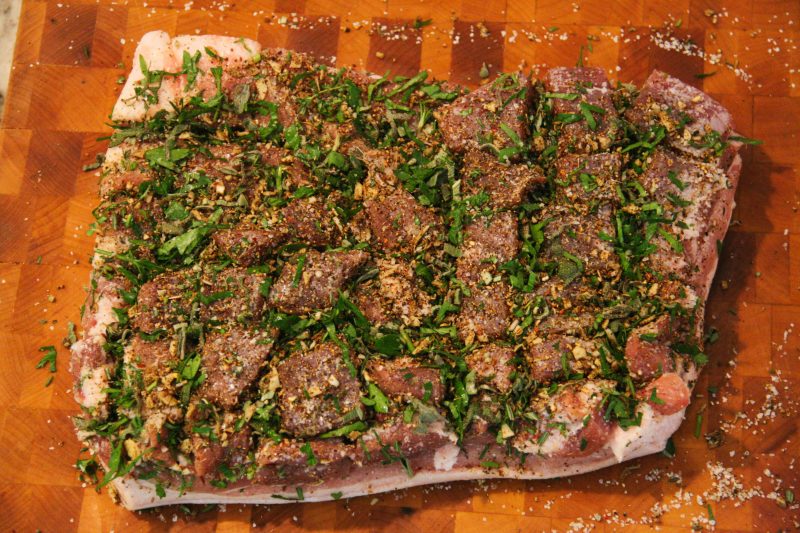
ROLLING AND TYING THE PORCHETTA
Roll the meat from the leanest side to the fattiest. Make sure to keep even pressure as your roll this as tight as your can. Keep the seam side of the roast against the cutting board and lay out your cut strings at even intervals down the entire length of the roast. Start from the outermost strings and work your way to the center making sure to tie them tight enough that the roast will not move but not so tight that it is bulging. Once you have this tied up, we are going to make a salt and baking soda mixture to rub all over the skin. While that may sound odd, and it did for me for a while, the baking soda will help break down the peptide bonds in the skin and help create that big and bubbly-crackly skin that we want. Isn’t science great!
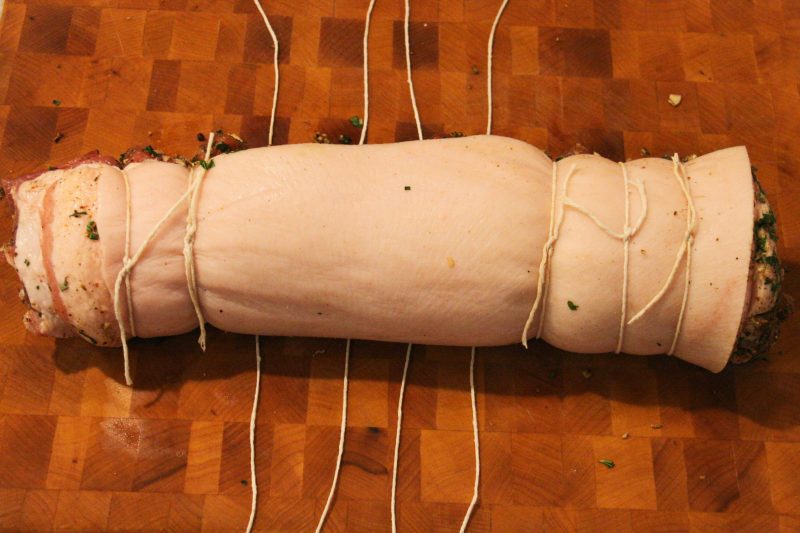
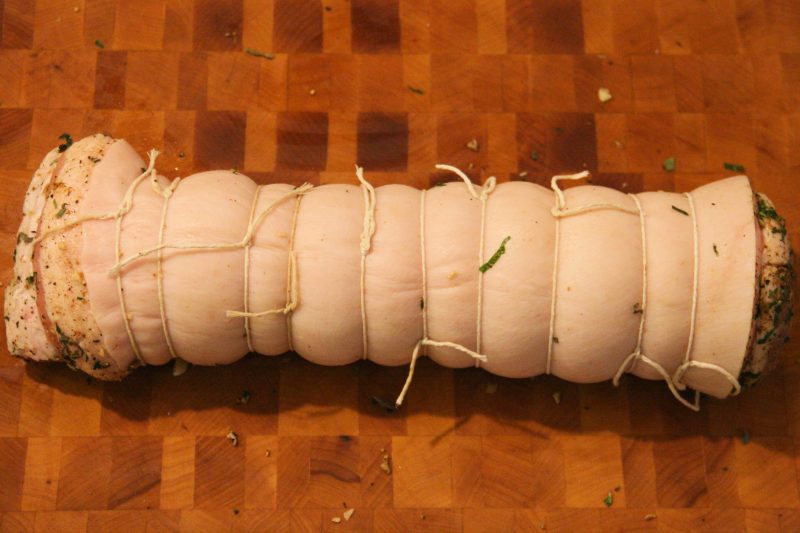
Our next step is going to be wrapping the roast in plastic wrap as tight as you can and let it rest in your refrigerator for 1-2 days, the longer the better but no more than 3.
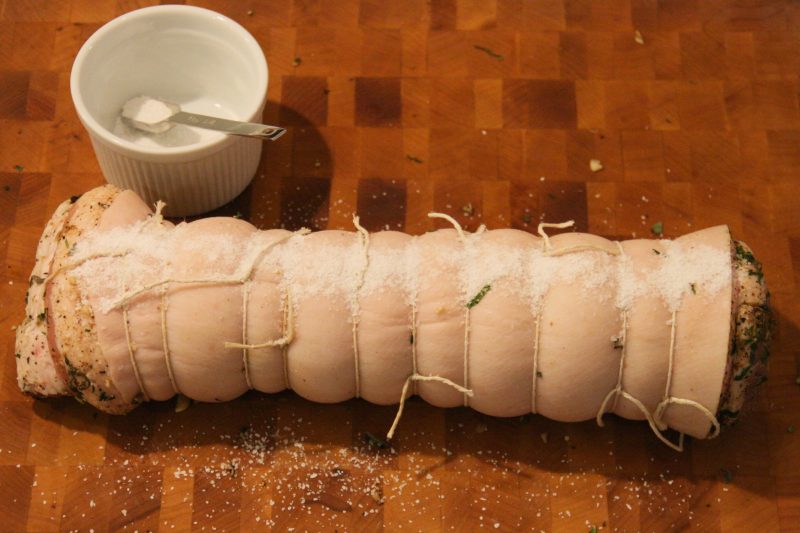
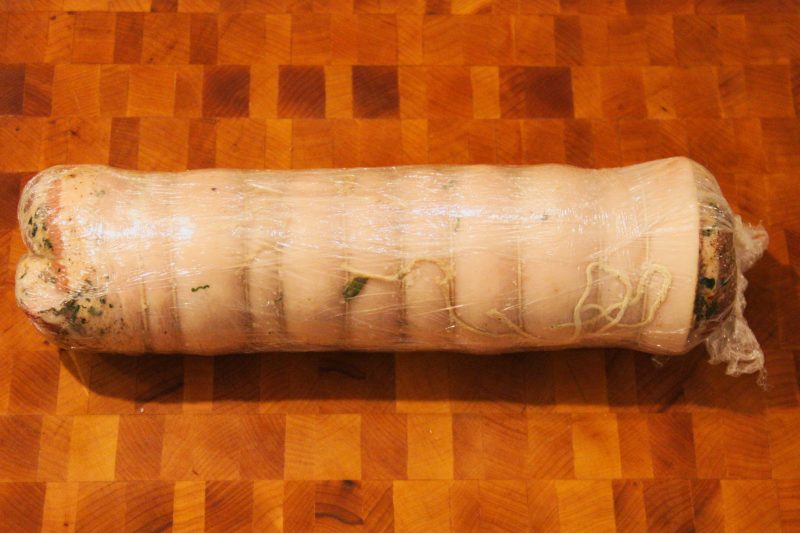
USING YOUR ROTISSERIE TO ROAST
On cook day remove the pork and take off the plastic wrap. Preheat your grill to around 300-320°F (149-160°C) and set up your rotisserie attachment. You can keep a close eye on your temperature with the Quad XPro Thermometer. Once the grill is hot it’s time to skewer the porchetta and get it roasting. Inset the rotisserie spit into the exact center of the pork and shift the roast to the center of the spit and secure with the spit forks. Place an aluminum pan under the pork. Turn off the middle burner, or move your coals to one side and roast over indirect heat for 2.5 hours, at this time the pork have an internal temperature of 160°F (71°C). You will want to bast the roast every 20 minutes with the accumulated pan drippings.
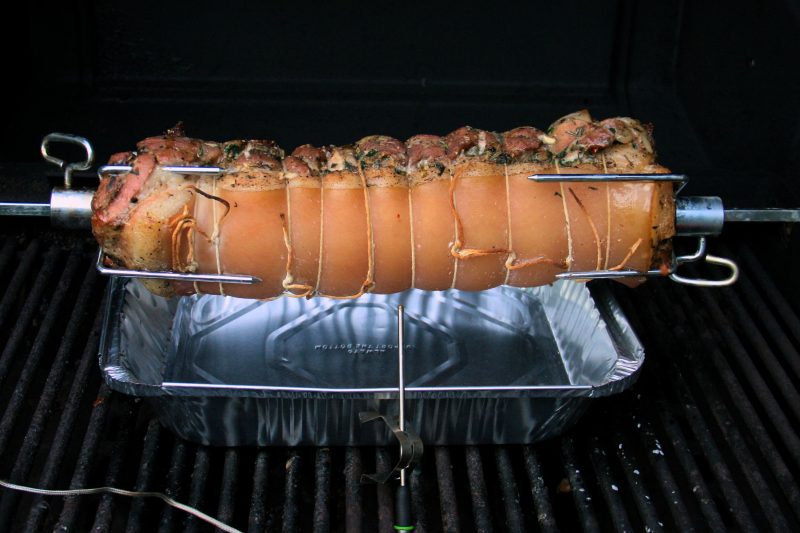
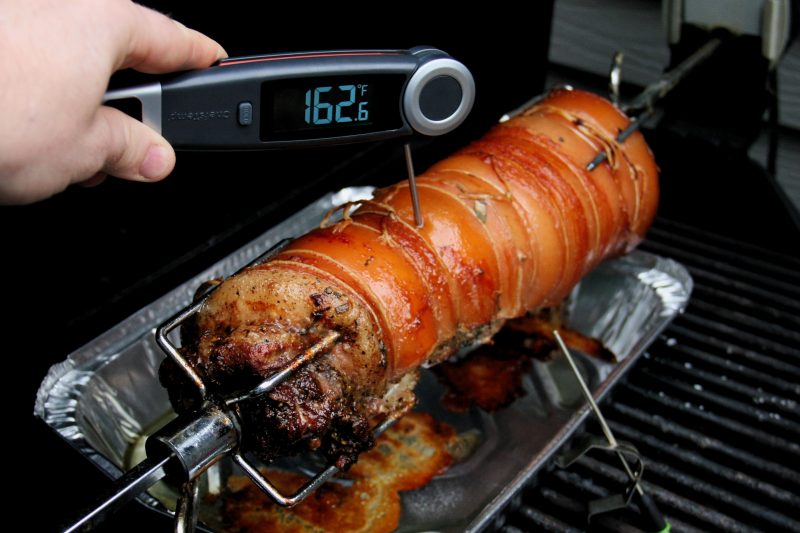
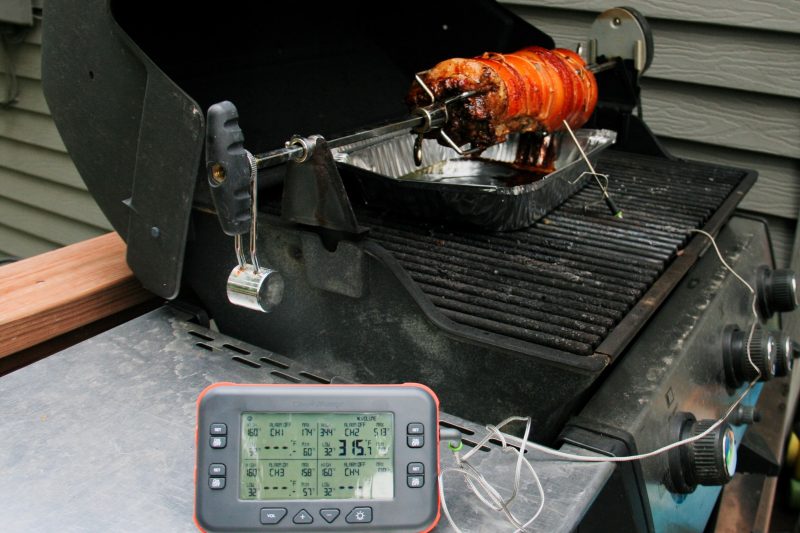
..
Continue to roast till the internal temperature reaches an 190°F (88°C), or the probe of your Finaltouch X10 thermometer, can be cleanly inserted through the skin with little resistance from the meat.
Turn on your rotisserie burners to full and watch as the pork skin starts to pop and crackle. This is a very precarious time as you want to manage the heat, so it doesn’t burn the skin before the entire outside is perfectly crispy.
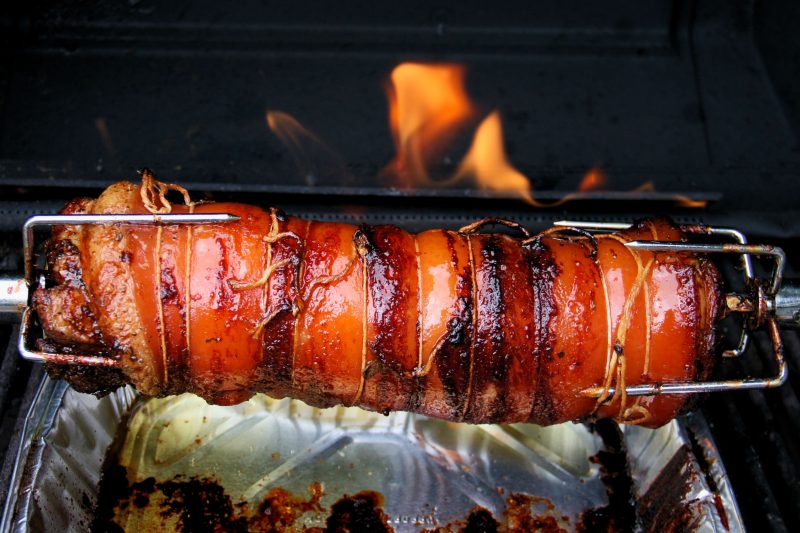
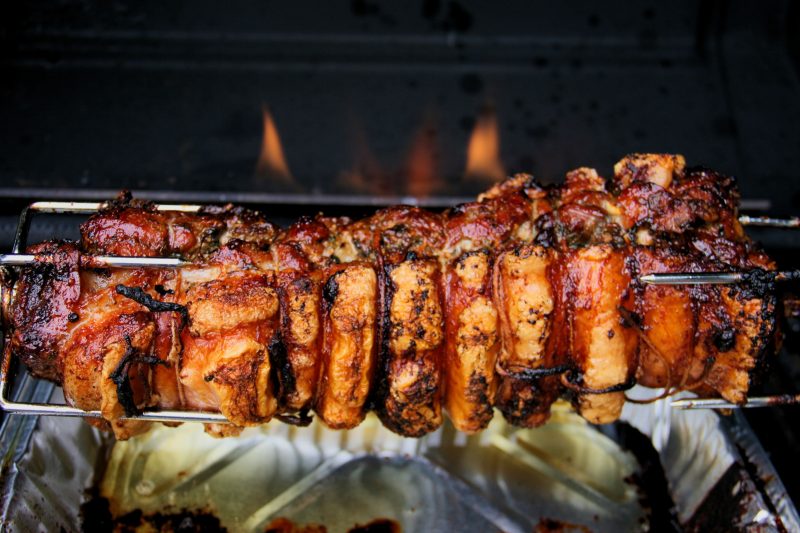
Remove the whole spit from the grill and place on your cutting board. Let the pork rest for 10-15 minutes before removing from the spit and slicing. This is best done with a serrated knife verses a chef’s knife to cut through the crispy skin.
EASY TRADITIONAL ITALIAN PORCHETTA
INGREDIENTS
- 4-5# Pork Belly
- Kosher Salt
- 5T Whole Black Pepper Corns
- 2T Whole Fennel Seed
- 2tsp Crushed Red Pepper Flakes
- 4T Mixed herbs (sage, thyme leaves, rosemary, and little parsley)
- 8 cloves of garlic minced
- 1tsp baking powder
- Kosher Salt
INSTRUCTIONS
1-2 Days before you roast
Prepare the Porchetta
- Place the pork belly on you cutting board skin side down and deeply score the flesh about halfway to the skin. Make a crisscross pattern to create lots of little nooks and crannies for the spice blend to go.
- Liberally salt the meat with kosher salt. While that sits toast your spices in a dry skillet till just brown and fragrant, turn off the heat and add the red chili flakes. Remove to a spice grinder or mortar and pestle and let cool. Coarsely grind then mix with fresh herbs and minced garlic. Rub this mixture into the belly, making sure to massage it into all the slits in the meat.
- Tightly roll the meat into a log, starting with the thinnest end to the fattest. Tie this with butchers’ twine at even intervals, starting with the outside and working your way to the center. Combine 2 T Kosher salt and 1tsp baking powder in a side bowl. Rub this all over the skin of the pork.
Tightly wrap in plastic and place in your refrigerator overnight or up to 3 days.
Cook Day
- Preheat your grill to 300 degrees, once hot make an indirect fire setup for the pork.
- Unwrap your pork and run the rotisserie spit through the very center of the roast, then secure the roast with the spit forks.
- Place a drip pan under the pork and roast it for 2.5 hours, at this time the pork should have an internal temperature of 160°F (71°C). You will want to baste the roast every 20 minutes with the accumulated pan drippings. Continue to roast till the internal temperature reaches an internal temperature of 175°F (80°C), or the probe of your Finaltouch X10 thermometer, can be cleanly inserted through the skin with little resistance from the meat.
- Turn your rotisserie burner on to full blast or remove the drip pan and turn your middle burner on high heat. Carefully watch as the skin crackle and browns. Make sure to monitor your heat so you don’t burn the skin.
- Remove the whole spit from the grill and place it on your cutting board. Let rest for 10-15 minutes before removing from the spit and slicing. This is best done with a serrated knife verses a chef’s knife to cut through the crispy skin.
Discover Other ChefsTemp Products
Discover more recipes and learn kitchen tricks by joining our cooking family on Facebook.
You may also like:















